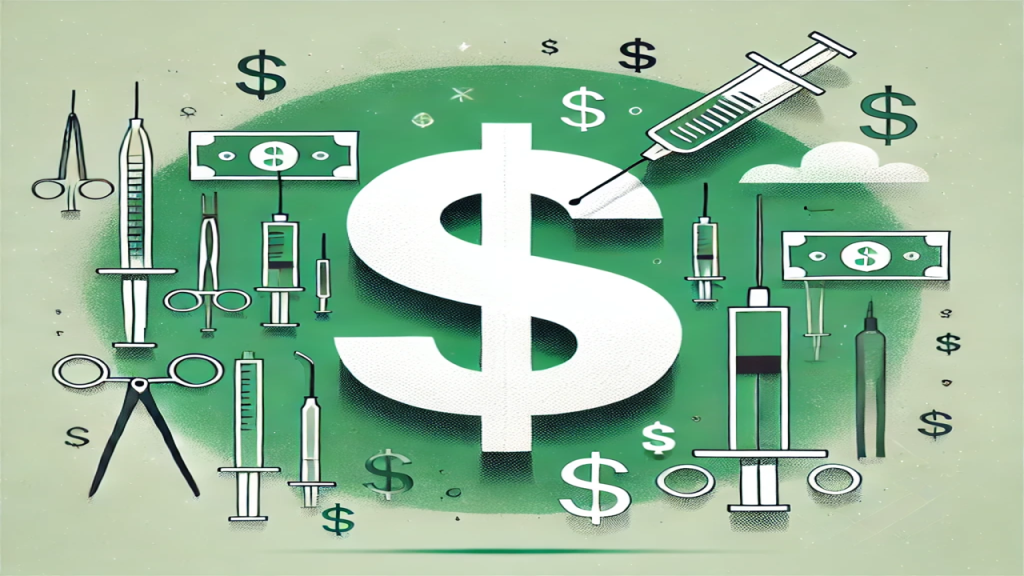US Cosmetic Surgery: The True Price of Cosmetic Surgery 2025

US Cosmetic surgery has become an increasingly popular way for individuals to enhance their physical appearance, boost self-confidence, and address aesthetic concerns. However, the cost of these procedures can vary widely across the United States, leading many to wonder what factors influence the price of cosmetic surgery. Whether you’re considering a facelift, breast augmentation, rhinoplasty, or any other cosmetic procedure, understanding the key elements that drive costs can help you make informed decisions and plan your finances.
In this comprehensive guide, we’ll explore the various factors that affect the cost of cosmetic surgery in the United States, including geographical location, surgeon expertise, the type of procedure, facility fees, anesthesia costs, and post-surgical expenses. By the end of this article, you will have a clear understanding of the different aspects that contribute to the overall price of US cosmetic surgery.
Table of Contents
1. Geographical Location
One of the most significant factors influencing the cost of US Cosmetic Surgery is the geographical location where the procedure is performed. The cost of living and demand for cosmetic procedures vary from region to region, which directly affects the pricing.
Urban vs. Rural Areas
US Cosmetic surgery tends to be more expensive in major metropolitan areas compared to rural or suburban regions. In cities like Los Angeles, New York, or Miami, where demand for cosmetic surgery is high, you can expect to pay more for procedures due to the competitive market and higher overhead costs for surgeons. In contrast, rural areas or smaller cities with lower demand may offer more affordable pricing.
Regional Trends
Different regions of the U.S. have varying trends and preferences when it comes to cosmetic procedures. For instance, body contouring procedures like liposuction and Brazilian butt lifts are more popular in cities like Miami, which can drive up prices due to high demand. Meanwhile, facial procedures like rhinoplasty might be more common in other areas. It’s essential to consider these regional trends when estimating the cost of surgery in a specific location.
2. Surgeon’s Expertise and Reputation
The experience, training, and reputation of the surgeon performing the cosmetic procedure play a significant role in determining the cost. Highly experienced surgeons with a track record of successful surgeries and satisfied patients often charge higher fees.
Board-Certified Surgeons
Choosing a board-certified plastic surgeon is critical for ensuring both safety and quality results. Board-certified surgeons have undergone rigorous training and are held to high standards of care. However, this level of expertise often comes at a premium, with board-certified surgeons generally charging more than non-certified practitioners.
Surgeon’s Reputation and Demand
Surgeons who have built a strong reputation in the field, especially those who have garnered celebrity clientele or have been featured in the media, may command higher fees. Their services are in high demand, and their pricing reflects their stature in the industry.
While choosing a highly reputable surgeon may cost more, patients often feel more confident knowing they are in the hands of an expert with proven results.
3. Type of Procedure
The specific cosmetic procedure you choose is one of the most direct influencers of cost. Some procedures are more complex and time-consuming, leading to higher prices.
Surgical Procedures
Surgical cosmetic procedures tend to be more expensive than non-surgical alternatives because they involve more time, expertise, and resources. Here are some examples:
- Breast Augmentation: One of the most popular US Cosmetic Surgery, breast augmentation, typically costs between $6,000 and $12,000 depending on the type of implants used and the complexity of the surgery.
- Liposuction: The price for liposuction can range from $3,000 to $7,000 per area treated, depending on the size of the area and the amount of fat being removed.
- Facelift: Facelifts are complex procedures that can cost anywhere from $8,000 to $15,000 or more, depending on the extent of the surgery and additional procedures like neck lifts or brow lifts.
- Tummy Tuck (Abdominoplasty): A tummy tuck can range from $8,000 to $12,000, depending on the amount of tissue removal and contouring involved.
Non-Surgical Procedures
Non-surgical procedures such as Botox injections, dermal fillers, and laser treatments are generally less expensive than surgical options, though they often require multiple treatments over time to maintain results. For example:
- Botox: Typically costs between $300 and $600 per session, depending on the number of units used and the area being treated.
- Dermal Fillers: The cost of fillers like Juvederm or Restylane can range from $600 to $2,000 per syringe, depending on the brand and the treatment area.
Since non-surgical treatments are often temporary, the cost can add up over time if you need multiple sessions to maintain the results.
4. Anesthesia Costs
The type of anesthesia used during US Cosmetic Surgery is another significant cost factor. Depending on the complexity of the procedure, your surgeon may recommend either local anesthesia, IV sedation, or general anesthesia.
Local Anesthesia
Local anesthesia is the least expensive option because it numbs only a specific area of the body and doesn’t require an anesthesiologist to be present. Procedures performed under local anesthesia tend to be less invasive, such as minor liposuction or mole removal, which makes them more affordable.
General Anesthesia
For more extensive procedures like tummy tucks or breast lifts, general anesthesia is required. General anesthesia adds to the overall cost of the US Cosmetic Surgery since it requires an anesthesiologist or a certified registered nurse anesthetist (CRNA) to be present throughout the procedure. The cost of anesthesia for a typical cosmetic surgery can range from $500 to $2,500 or more.
5. Facility Fees
The facility where the surgery takes place also influences the overall cost. Surgical procedures performed in an accredited surgical center or hospital typically come with higher facility fees compared to those done in a private clinic or outpatient center.
Accredited Surgical Centers
Accredited surgical centers are required to meet specific safety and health standards, and they are equipped with advanced medical equipment to handle any complications that may arise. While these centers offer greater peace of mind, they also come with higher facility fees.
Hospital Settings
If your US cosmetic surgery needs to be performed in a hospital due to its complexity or potential risks, expect to pay more. Hospitals often charge higher fees than outpatient centers because of the additional resources and staff required to ensure patient safety.
6. Pre-Operative and Post-Operative Care
US Cosmetic surgery costs don’t end once the procedure is completed. Pre-operative consultations, follow-up appointments, medications, and post-surgical garments all contribute to the overall cost of the surgery.
Consultation Fees
Many surgeons charge an initial consultation fee to assess your needs, discuss your goals, and determine whether you’re a good candidate for the procedure. This fee can range from $100 to $500 or more, depending on the surgeon’s reputation and location.
Follow-Up Appointments
After your surgery, you will need to attend follow-up appointments to ensure proper healing and address any complications. These visits may be included in the overall cost, but in some cases, they are billed separately.
Post-Surgical Garments
Depending on the type of surgery you undergo, you may need to wear compression garments or specialized support to aid in healing. These garments can cost anywhere from $50 to $300, depending on the type and duration of use.
Medications
Prescription medications for pain management, antibiotics, or other post-operative needs can add to the total cost of the surgery. While these costs are generally minor compared to the overall procedure, they are still an important consideration in budgeting for surgery.
7. Complexity of the Procedure
The more complex a cosmetic procedure, the more time and resources it will require, which naturally leads to higher costs. Complex surgeries often involve multiple steps, longer operating times, and a higher level of expertise.
Combination Procedures
Some patients opt for combination procedures, such as a mommy makeover (which typically includes a tummy tuck, breast augmentation, and liposuction). While these combination procedures offer the benefit of addressing multiple concerns at once, they also increase the cost due to the extended surgical time and additional resources required.
Revision Surgeries
If you need a revision surgery to correct or enhance the results of a previous procedure, this can add to the cost. Revision surgeries are often more complicated and time-consuming than the initial procedure because the surgeon may need to work with scar tissue or address complications from the original surgery.
8. Financing Options and Insurance Coverage
Most cosmetic surgeries are elective, which means they are not covered by health insurance. However, some procedures that are deemed medically necessary, such as reconstructive surgeries after an accident or mastectomy, may be covered by insurance.
Financing Plans
Many plastic surgery practices offer financing options to help make cosmetic procedures more affordable. These plans allow patients to spread out the cost of surgery over several months or years, often with interest. It’s important to carefully review the terms of any financing plan to ensure you understand the total cost over time.
Health Savings Accounts (HSAs) and Flexible Spending Accounts (FSAs)
If your cosmetic surgery has a functional or reconstructive component, you may be able to use funds from an HSA or FSA to cover some of the costs. These accounts allow you to set aside pre-tax dollars for qualified medical expenses, which can reduce the financial burden of surgery.
Conclusion
The cost of cosmetic surgery in the United States is influenced by a wide range of factors, from geographical location and surgeon expertise to the type of procedure and associated fees. Understanding these factors is essential for making informed decisions about your surgery and budgeting appropriately. While cosmetic surgery can be a significant investment, the benefits of
improved self-confidence and satisfaction with your appearance can make it a worthwhile endeavor.
When considering cosmetic surgery, it’s crucial to do thorough research, consult with multiple surgeons, and carefully weigh all costs involved, including pre- and post-operative care. By understanding the various elements that influence the cost, you’ll be better equipped to plan your cosmetic journey and achieve your desired results.


